|
Limitar tu búsqueda
[+–] Compilador o editor
[+–] Editorial
[+–] Fecha
[+–] Formato
[+–] Idioma
[+–] Tipo de documento
[+–] Tipo de recurso
[+–] Classification
|

|
|
Evolución actual de los regímenes de pensiones
La compilación aquí expuesta se estructuró de manera tal que el lector tenga en primer plano una idea de lo que la problemática en torno a las pensiones representa en la región latinoamericana, así como un panorama internacional respecto a los sistemas pensionarios, lo cual exponen en forma magistral el Dr. Alvaro Castro Gutiérrez y la Lic. Olga Palmero Zilvetti en sus respectivas...
|
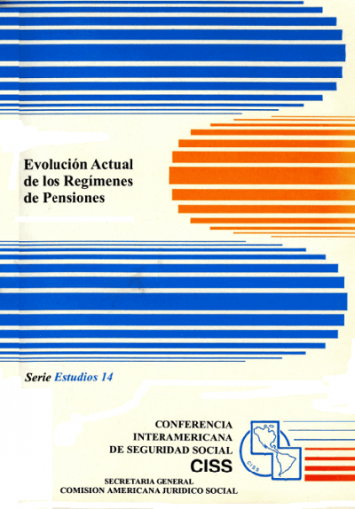
|
|
|
|

|
|
La epidemiología en la seguridad social: prioridades
Se presentan en ocho capítulos los elementos introductorios a la epidemiología de los problemas de salud emergentes, los programas de vigilancia epidemiológica y control prioritarios, los retos para la epidemiología en el Instituto Mexicano del Seguro Social, el laboratorio como componente básico de la vigilancia epidemiológica, la formación y capacitación en epidemiología, las inmunizaciones y...
|

|
|
|
|

|
|
Prioridades en salud reproductiva
En el documento se incluye un análisis sobre algunas de las prioridades en salud reproductiva, basado en la experiencia acumulada en el Instituto Mexicano del Seguro Social en el transcurso de dos décadas, a partir de la iniciación de estas actividades a finales del año de1972. Los temas seleccionados se encuadran en cinco capítulos relacionados con el origen y el desarrollo del enfoque de salud...
|
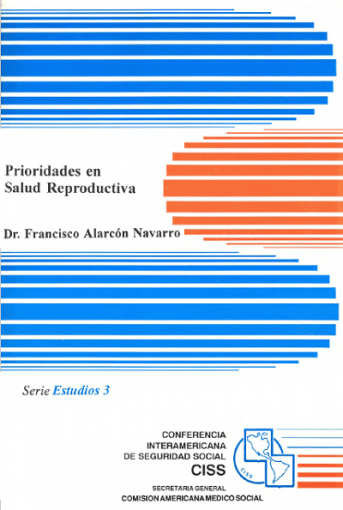
|
|
|
|

|
|
Informe de la Secretaría General de la CISS: periodo de diciembre de 1989 a noviembre de 1990
Contenido: 1 Introducción. 2 Nuevas autoridades de la Conferencia. 3 Acción de las comisiones americanas de seguridad Social. 4 Acción del CIESS. 5 Relación con otros organismos internacionales. 6 Cooperación técnica horizontal. 7 Sistema de información de la seguridad social americana. 8 Afiliación. 9 publicaciones. 10 Situación financiera.
|
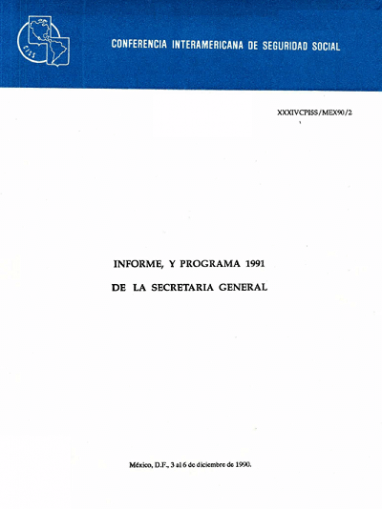
|
|
|
|

|
|
Public spaces in Mexico as social cohesion promoters: an structural modeling perspective
This research assessed the effects of several contextual factors (e.g, neighborhood insecurity, evaluation of public spaces, infrastructure, low risk behaviors) on social cohesion and residential satisfaction, in the context of low and medium-low socio economic status of individuals nearby renovated public spaces (parks and recreational facilities) in Mexico. The research method is based on...
|

|
|
|
|

|
|
Reunión Técnica de la CAJS: El derecho social. Herencia para el nuevo siglo
Ponencias presentadas durante la Reunión Técnica de la Comisión Americana Jurídico Social, celebrada los días 24 y 25 de noviembre de 1999, en la Ciudad de México.
Contenido: El derecho a la protección de la salud. Garantía social de los mexicanos / Leobardo C. Ruiz Pérez; El proceso de reforma en Costa Rica y el Convenio 102 de la OIT / Humberto Gómez Alfaro; Examen del Derecho Social español...
|
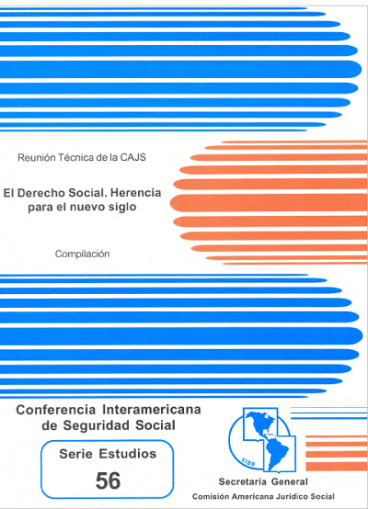
|
|
|
|

|
|
Do investments in public spaces generate social capital? Evidence for Mexico
The formation of social capital is critical for developing countries. This paper investigates the effects of attempts to recover public spaces in marginalized areas of Mexico. The effects are estimated through balancing in the propensity scores. We focus on the results of perception of safety, support and social capital. When efforts are made to recover public spaces, the perception of safety...
|

|
|
|
|

|
|
The effect of the perception of violence on social capital in Mexico
Increasing levels of violence in Mexico, which have the potential to damage the very fabric of 1 society, as well as impact key economic variables, led us to analyze the effect that changes in the perception of violence had on social capital fluctuations (including associative capital) between 2006 and 2011. This was a period in which an anti-violence and anti-organized crime policy was launched...
|
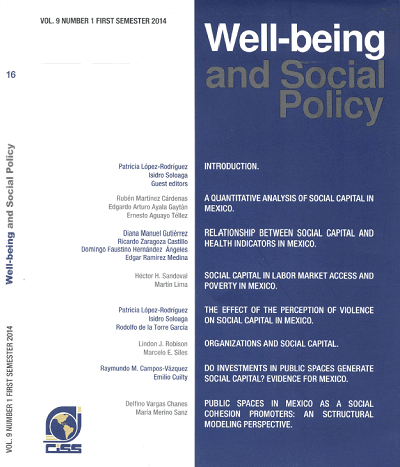
|
|
|
|

|
|
Social capital in labor market access and poverty in Mexico
Social capital, defined as the set of social networks that a person has in order to obtain benefits, is used by the population as a mechanism for providing resources, to cushion shocks in consumption and to obtain information on available employment opportunities. This study employs a logistic model to characterize the manner in which people access the labor market in Mexico through the use of...
|

|
|
|
|

|
|
Relationship between social capital and health indicators in Mexico
This study analyzes the relationship between social capital types and access to health services in Mexico. To this end, access to healthcare data from the 2006 ENCASU and 2011 ENCAS was validated using 2006 and 2012 ENSANU results. Indicators were found to be consistent. A statistical analysis of the distribution of social capital and health indicators by region, as well as by rural or urban area...
|
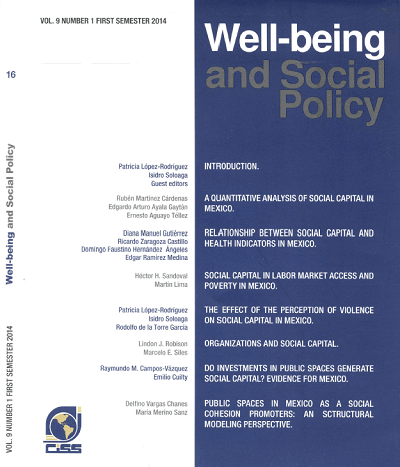
|
|
|
|

|
|
A quantitative analysis of social capital in Mexico
Se ha relacionado el capital social a la eficiencia en los mercados (Arrow, 1972), al refuerzo del contrato (Durlauf y Fafchamps, 2004) y en general al desarrollo y bienestar (Keefer y Knack 1997; Putnam 2000; Knack y Zak 2003). En el presente trabajo hemos investigado los determinantes del capital social empíricamente, centrándose en tres medidas comunes aproximadas de este: dos ligadas a la...
|

|
|
|
|

|
|
Analysis of the use of financial services by companies in Mexico: What does the 2009 Economic Census tell us?
We present a descriptive analysis of the results of Mexico's 2009 Economic Census regarding the use of bank credit and accounts by productive entities (companies). INEGI was requested to prepare a set of statistics regarding various company characteristics that are relevant to the decisions made by institutions offering banking services. Information was grouped according to company size and to...
|
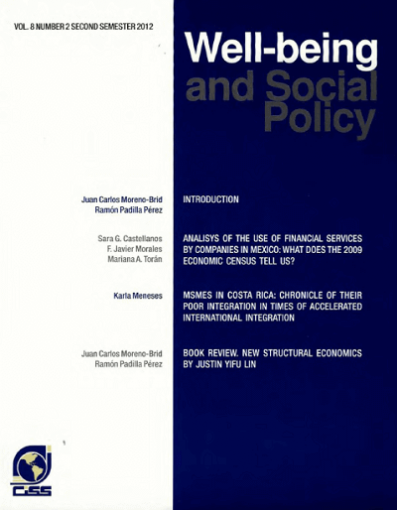
|
|
|
|

|
|
Social security pensions and retirement decisions in Mexico
Using Mexican cohort data for 1991-2000 this article examines the relationship between retirement decisions —the transition from work to labor market inactivity— and social security (contributive) pensions in less developed countries. The available large time series also makes possible to examine how a financial crisis that took place in 1995 has affected retirement incentives. In most Latin...
|

|
|
|
|

|
|
Promised and actual benefits in mexican social security fot rhe transtion generation
Este artículo presenta un conjunto de mediciones de los costos y beneficios reales del plan general de retiro por jubilación proporcionado a los ciudadanos por parte del Sistema Mexicano de Pensiones (SMP), que son necesarias para evaluar las decisiones de los trabajadores en cuanto a la contribución a la seguridad social (es decir, trabajar en el sector formal) y al retiro. El SMP ofrece dos...
|

|
|
|
|

|
|
A simple poverty scorecard for Mexico
This study uses Mexico's 2008 National Household Survey of Income and Expenditure to I construct an easy-to-use scorecard that estimates the likelihood that a household has income below a given poverty line. The scorecard uses ten simple indicators that field workers can quickly collect and verify. Poverty scores can be computed on paper in the field in about five to ten minutes. The scorecard's...
|
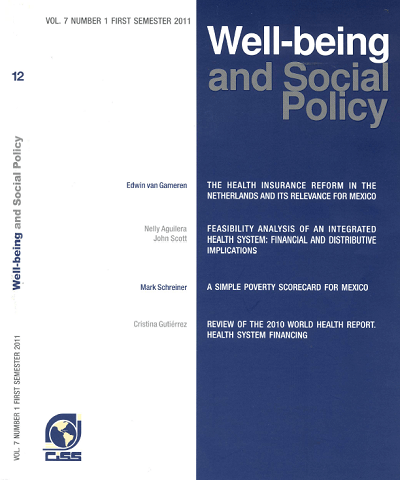
|
|
|
|

|
|
Feasibility analysis of an integrated health system: financial and distributive implications
The document presents spending projections and projections of the distributive incidence for an Integrated Health System under three basic scenarios: status quo, a two pillar scheme (financed through general taxes and private spending) and a three pillar scheme (financed through general taxes, social security contributions and private spending). By presenting these simulations, the study enhances...
|
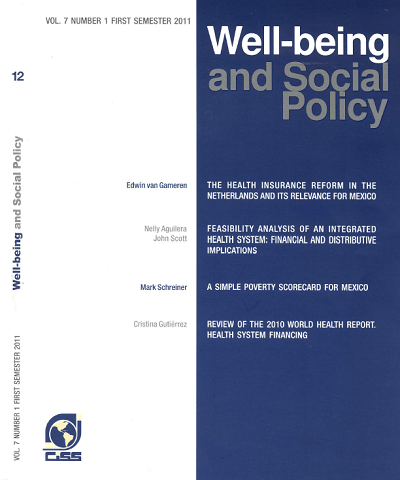
|
|
|
|

|
|
The health insurance reform in the Netherlands and its relevance for Mexico
Alrededor del mundo se observan dos versiones de la organización de los seguros de salud; la seguridad social basada en el empleo, y los servicios nacionales de salud. En Latinoamérica regularmente se usa la primera, pero se está lejos de lograr la cobertura universal. En los Países Bajos encontramos una peculiar mezcla de obligaciones públicas y responsabilidades privadas. La cobertura universal...
|

|
|
|
|

|
|
Natural disasters and poverty in Latin America: welfare impacts and social protection solutions
The Inter-American Conference on Social Security (CISS) and the United Nations Development Programme (UNDP) Office in Mexico jointly organized the conference “Natural Disasters in Latin America: Welfare Impacts and Social Protection Solutions” held in Mexico City in January 2010. The main objectives of the conference were to improve the understanding of (i) how natural disasters affect...
|
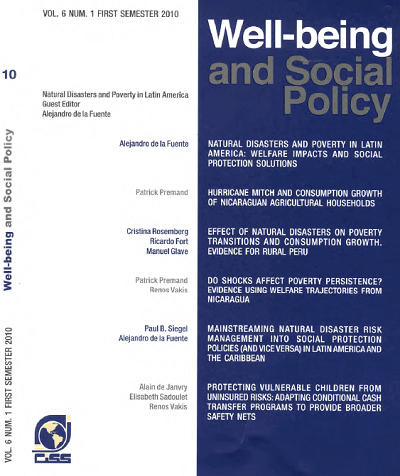
|
|
|
|

|
|
Calidad, elemento esencial de la seguridad social
Esta publicación pretende animar y continuar con el esfuerzo para que el otorgamiento de los servicios sea más oportuno, eficiente, satisfactorio y efectivo, con lo que estaremos en posibilidades de garantizar un mejor estado de salud en la población derechohabiente al iniciarse el nuevo milenio. Este documento y propone de una manera sencilla y clara algunas ideas.
|

|
|
|
|

|
|
Reunión Técnica de la CAJS: Tendencias jurídicas de los sistemas de seguridad social en América
Ponencias presentadas durante la Reunión Técnica de la Comisión Americana Jurídico Social y la III Reunión Internacional del Grupo de Estudios sobre la Mujer, celebradas el 28 y 29 de noviembre de 2001, en la Ciudad de Fortaleza, Brasil.
Contenido: La Experiencia Jurídica del ISSSTE: Un Reto de Viabilidad Financiera y Bienestar / Benjamín González Roaro; Nuevas Alternativas de Previsión Social...
|

|
|
|
|
|